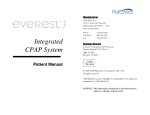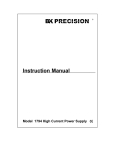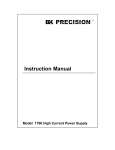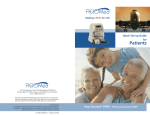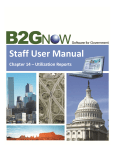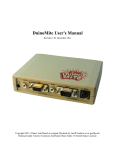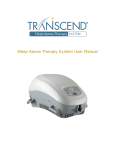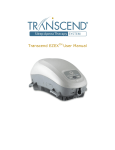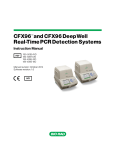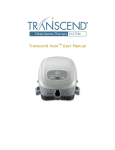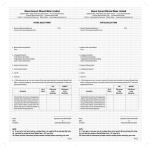Download Everest 2 CPAP System User Manual
Transcript
Manufacturer and AEIOMed, Inc. 1313 5th Street SE, Suite 205 Minneapolis, MN 55414 USA Phone: Toll Free: Fax: 612.455.0550 866.722.2507 612.455.0551 Revision Record Integrated CPAP System Patient Manual Everest® and Everest ®2 Integrated CPAP System Patient Manual 101011 Rev B E2PM Revised: 06-2007 © 2007 AEIOMed, Inc., Minneapolis, MN USA All rights reserved. AEIOMed®, Everest® and HeadRest® are registered trademarks of AEIOMed, Inc. DataRest™ is a trademark of AEIOMed, Inc. NOTICE: The information contained in this document is subject to change without notice. Contents Precautions for Use......................................................................1 Inspecting the CPAP Components...............................................5 Standard User Modes ..............................................................7 Buttons .....................................................................................7 Powering the Everest CPAP Device ............................................8 Using AC Line Power...............................................................8 Using the Optional Battery Pack ..............................................9 Using the Optional Battery Pack and AC Line Power............10 Checking the Battery Pack’s Capacity...................................11 Changing Battery Cells ..........................................................12 Using the Optional Mobile Adapter ........................................13 Using the Optional Battery Pack and Mobile Adapter ...........14 Starting Therapy.........................................................................16 Humidifier Preheat (Optional Step)........................................21 Turning on the Blower............................................................22 Stopping Therapy...................................................................25 Adjusting Patient Settings ..........................................................26 Accessing Patient Settings ....................................................26 Therapy Session Information .................................................28 Cleaning Instructions..................................................................30 Specifications .............................................................................32 Manufacturer’s Declaration ........................................................34 Limited Warranty ........................................................................37 Troubleshooting..........................................................................39 Appendix 1: Reorder Numbers...................................................41 Precautions for Use This section describes the contraindications, warnings, and cautions associated with use of the Everest® Integrated CPAP System. The following guidelines apply to this document: WARNING CAUTION NOTE • • • Indicates the possibility of serious injury or death to yourself or others. • Indicates the possibility of minor injury or damage to the equipment. Indicates a tip or feature to aid efficient operation of the device. • • Indications for Use The Everest and Everest 2 Integrated CPAP Systems are intended for the therapy of adults over 66 pounds (30 kg) with Obstructive Sleep Apnea (OSA). The devices deliver continuous positive airway pressure (CPAP), which prevents the collapse of the upper airway, thereby preventing obstructions that can interfere with spontaneous breathing. NOTE: • • • • Unless otherwise specified, references to “Everest” throughout this manual refer to both the Everest and Everest 2 Integrated CPAP Systems. • • 1 2 Warning Caution: Federal law (United States) restricts this device to sale by or on the order of a physician. This device is not intended for life support. The Everest®2 Integrated CPAP System must be set up and adjusted by a trained CPAP provider before it can be used for therapy. When operating properly, the CPAP system flushes out exhaled air through the vent in the patient interface. Exhaled air could be re-breathed if the CPAP blower is off, not operating properly, or the vent is blocked. Re-breathing exhaled air for longer than several minutes can, in some circumstances, lead to suffocation. The air temperature produced by this device can be as much as 10ºF higher than the temperature of the room. Exercise caution if the room temperature is warmer than 90ºF (32ºC). In ambient temperatures greater than 95ºF (35ºC), the CPAP unit must be placed at least 5 feet (1.5m) away from the user. Do not block or otherwise obstruct the exhalation ports of the patient interface. Follow the Patient Interface Instructions for your interface. This equipment is not suitable for use in the presence of a flammable anesthetic mixture with air or with oxygen or nitrous oxide. Emptying and cleaning the humidifier reservoir daily will help to prevent mold and bacteria growth. Use of accessories or a humidifier other than defined in this manual is potentially unsafe. The CPAP system is only to be used with the supplied and recommended accessories. Use of accessories not recommended may result in increased emissions or decreased immunity of the CPAP system. The CPAP system should not be used adjacent to or stacked with other equipment. If adjacent or stacked use is necessary, the CPAP system should be observed to verify normal operation. • • • • • • • • • • • • • • • Oxygen Use Warnings If oxygen is used with this device, the oxygen flow must be turned off when the device is not in operation. Turn the device on before turning oxygen on. This will prevent oxygen from accumulating in the device. Do not inject oxygen through the air inlet of the device. At a fixed flow rate of supplemental oxygen, inhaled oxygen concentration will vary depending on the pressure settings, patient breathing patterns, mask selection, and leak rate. Caution Do not sterilize the CPAP system. Power the CPAP system only from the AEIOMed® supplied power supply, optional battery pack, or mobile power supply. Reference Appendix 1 for Reorder Numbers. Reference the Everest® Integrated CPAP Patient Manual only after receiving appropriate training in the use of the CPAP system. At low CPAP pressures, the flow through the exhalation port may be inadequate to clear all exhaled gas from the airway. Some re-breathing may occur. Use patient interface devices with a leak flow rate of at least 12 L/min at 4 cm H2O. Contact your healthcare provider if you experience redness or skin irritation. Discontinue use of the CPAP device or humidifier if respiratory irritation occurs. Do not introduce liquids or objects into the CPAP device’s air inlet/outlet connector. Inspect the power cord for signs of wear or damage before each use. Replace the power cord if necessary. Reduce the humidity level if you observe excessive moisture in the flexible tubing. For safe operation, place the humidifier lower than the user. 3 • For proper operation, the humidifier must be level. • AEIOMed, Inc. recommends replacing the 22 mm 6’ Output Hose after 6 months use. • Use the humidifier only for its intended purpose as described in this manual. • Use only those accessories provided or recommended by AEIOMed, Inc. • Do not operate the humidifier if any of the parts are damaged, if it is not working properly, or if the humidifier has been dropped or mishandled. • Do not use the humidifier if the water reservoir is leaking or is damaged in any way. Replace damaged parts before continuing use. • To protect the environment, some parts and accessories of the CPAP system must be disposed of in accordance with local regulations. • Do not submerge the humidifier in any fluids; damage may occur. • The humidifier reservoir must be filled with distilled water to the MAX fill line (see humidifier lid) at the beginning of each therapy session. Contraindications The Everest® Integrated CPAP System is contraindicated in patients with the following conditions: • Bullous lung disease • Pathologically low blood pressure • Pneumothorax or pneumomediastinum. Pneumocephalus has been reported in users using nasal CPAP. Caution should be used when prescribing CPAP for susceptible users such as those with cerebral spinal fluid (CSF) leaks; abnormalities of the cribriform plate; and a prior history of head trauma; and/or pneumocephalus. 4 Inspecting the CPAP Components Optional DataRest™ Accessories When you receive the Everest® CPAP System package, unpack all items, including the manual, and inspect them to ensure they were not damaged during shipment. The DataRest Patient Kit contains the following additional components: Report any missing or damaged items to your home healthcare provider. • DataRest Docking Station • DataRest Data Card Both the Everest and Everest 2 Integrated CPAP Systems include the following items and an accessory pouch (not pictured): Power Supply Refer to DataRest Docking Station Instructions for Use for more information. CPAP Device Air Inlet Filter Power Cord Patient Manual 22mm 6’ Output Hose Optional Integrated Components Heated Humidifier Mobile Power Adapter Battery Pack Refer to Appendix 1 for reorder numbers. 5 6 Powering the Everest® CPAP Device Description of the Everest® and Everest 2 Integrated CPAP Systems The Everest CPAP System offers several choices for powering your CPAP device: AC line power (an electrical wall outlet), optional battery pack, or optional mobile adapter. The CPAP Systems deliver positive pressure from 4 to 20 cmH2O to the patient, as prescribed by the clinician. The therapeutic pressure is continuous. The display panel presents delivered pressure, settings of the device, and the duration of therapy completed. Using AC Line Power Attach the power cord to the power supply. Transformer to CPAP Unit Standard User Modes Normal operation consists of 3 states: Off, Standby, and On. Power Supply Cord Off: Not connected to a power source. Display is blank. Warning! Use only AEIOMed® supplied power cord. Standby: Connected to a power source, but the blower is off. The user can view compliance. Insert the power cord plug into AC line power. On: Blower is on. The display shows the pressure setting. This example shows the setting for the optional humidifier is at 3. To attach the power cord to the CPAP: Optional Humidifier operating at Setting 3 Buttons 1. Rotate the power supply’s connector of the power supply so the arrow symbol appears on the left side. 2. Insert the connector into the receptacle on the back of the Everest CPAP device. 3. The CPAP device is ready for use. Turns the blower off or on Manual ramp on or off when the blower is on; in Standby mode it is used to review Patient Settings Adjusts the optional humidifier’s heater settings when connected 7 CPAP Device 8 Connector Arrows Power Supply Cord Using the Optional Battery Pack Caution! Use only the AEIOMed® battery pack supplied by your homecare provider. Note: Charge the battery pack for at least 5 hours before the first use. 1. Slide the CPAP device along the notched track of the battery pack, and secure it snugly in place. (A) (A) Using the Optional Battery Pack and AC Line Power Note: If an electrical outlet is available, use it. This will charge the battery pack and allow maximum use when AC line power is not available, such as during a power outage. The CPAP device switches automatically to battery power in such events. Note: To charge the battery pack without the CPAP device attached, connect the power supply to the battery pack. Complete the steps in the section above, Using the Optional Battery Pack. Battery Pack 1. Rotate the connector of the CPAP Connector power supply so the arrow symbol appears on the (D) bottom. (D) 2. Rotate the connector of the battery pack so the arrow symbol appears on the left side. (B) 3. Insert the connector into the receptacle on the back of the Everest® CPAP device. (C) 2. Insert the connector into the receptacle on the back of the battery pack. 4. The CPAP device is ready for use. (B) (C) 3. Insert the battery pack connector into the back of the CPAP. 4. Insert the power cord plug into AC line power. 9 10 Power Supply Battery Pack Connector Battery Pack Receptacle Checking the Battery Pack’s Capacity Changing Battery Cells 1. Locate the Key on the bottom of the battery pack. Note: See Appendix 1 to order additional battery packs or battery cells. 2. Press and hold the Key. 1. Detach the Battery Pack from the CPAP device and humidifier. 3. Observe the number of illuminated lights, which provide an approximate indication of the capacity. 2. Disconnect any power sources. 3. Locate the battery cell screw located on the bottom of the battery pack. Loosen the screw with a flat blade screwdriver. The battery pack will retain the screw as you loosen it. KEY 4. Remove the battery cell from the battery pack. • 0 – 1 lights – Little or no charge remaining. • 4 lights – Full or near full charge. 5. Insert the new battery cell into the battery pack. AEIOMed® Note: For peak performance, recommends keeping the power supply or mobile Adapter connected to the battery pack even after all 4 lights are illuminated. Note: Battery life varies depending on the pressure and humidifier settings. Monitoring charge time vs. usage time will help you understand how to optimize battery operation for your system. 6. Tighten the screw. Note: Occasionally (once per month), allow the battery to discharge completely followed by fully charging it for at least 5 hours. This can help keep the battery operating close to its maximum capacity as it ages. Individual results may vary. 7. Reattach the CPAP components. 11 8. Reconnect the power connections. 12 Using the Optional Mobile Power Adapter (A) Caution! Use only the AEIOMed® mobile power adapter and cables available from your homecare provider. Your mobile power adapter is supplied with two cables: one to connect to your CPAP, and the other to connect to a mobile power receptacle. Using the Optional Battery Pack and Mobile Power Adapter Note: If a power receptacle for the mobile power adapter is available, use it. This will charge the battery pack and allow maximum use while traveling. Note: To charge the battery pack without the CPAP device attached, use the steps below. Complete the steps in the section above, Using the Optional Mobile Power Adapter. (B) 1. Connect both cables to the mobile power adapter base. 2. Attach the square connector to the back of the CPAP device, making sure to line up the arrows on the left side. (A) 1. Insert the mobile power adapter square connector into the receptacle at the back of the battery pack, making sure to line up the arrow symbols on the bottom. 3. Connect the oblong cable into the power adapter. (B) 2. Connect the second cable to the mobile power receptacle. 4. Plug the assembled adapter into the mobile power receptacle. 5. Ensure the CPAP display powers on. Note: If you have any problems, try unplugging the cables and reconnecting them, to make sure that you have a good connections. 13 14 Starting Therapy Using the Everest®2 CPAP with a Power Source Connected When a power source is connected to the Everest 2 CPAP device, the CPAP displays the total number of therapy hours♠ and a flashing hourglass symbol for 3 seconds. Your clinician or homecare provider may request that you report these hours. Without humidifier: 1. Make sure that the CPAP device is connected to a power source. (If necessary, refer to Powering the Everest® CPAP Device.) 2. Ensure the display is in Standby mode. 3. Attach the patient interface 22 mm airway connector to the 6’ flexible tubing. 4. Position the patient interface (mask), according to the instructions accompanying the patient interface selected by your care provider. Following the initial display of the therapy hours, the CPAP device is in Standby mode—the CPAP is ready, the blower is off, and the display shows the following: Example of the HeadRest® with Nasal Seal 5. Press the on/off button. Warning! Turn on the CPAP blower as quickly as possible after positioning the patient interface. Exhaled air could be re-breathed if the CPAP blower is off. Re-breathing exhaled air for longer than several minutes can, in some circumstances, lead to suffocation. Note: If the CPAP loses power while delivering therapy, it will immediately resume delivering therapy as soon as power is restored (the CPAP will skip the initial therapy hours and Standby screens) 6. The blower is on, and the display shows the therapeutic pressure setting. 7. Check that the hose and patient interface have a tight seal and that there is no excessive air leak. ♠ Therapy hours = operating time at therapy pressure, as monitored by the device. 15 16 With humidifier: Note: If you remove or do not securely position the patient interface, the device will automatically reduce the pressure in approximately 60 seconds. This is called Interface Interrupt. It occurs when your patient interface (mask) is not securely positioned on your face and the air leak is excessive. Secure the interface and the pressure will increase to the prescribed level when you resume breathing. Warning! The humidifier reservoir must be filled to the MAX fill line (see humidifier lid) with distilled water at the start of each therapy session. Caution! Do not submerge the humidifier in any type of liquid; damage may occur. The optional heated humidifier relieves nasal dryness and irritation in patients by adding moisture to the airflow. Note: If you do not breathe with a correctly positioned patient interface within one hour, the device will shut off the blower and enter Standby mode. Warning! If moisture collects in the hose (sometimes referred to as rainout), stop therapy and adjust the humidity setting. Reducing the humidity setting usually stops the collection of moisture. Warning! Do not spill water into the CPAP air outlet connector. Humidifier Lid Humidifier Reservoir Humidifier Base Humidifier Reservoir Bottom 1. Remove the humidifier reservoir from the humidifier base. 2. Attach the humidifier base to the bottom of the CPAP device. 17 18 10. Connect one end of the 6’ 22 mm flexible tubing to the humidifier connector. CPAP 11. Attach the patient interface airway connector to the 6’ flexible tubing. PUSH HERE Humidifier Base 3. Ensure the humidifier lid is securely seated on the reservoir bottom. The clear lid has slots that fit tightly over the tabs, protruding from the rear of the reservoir bottom. 4. Ensure that the clear lid is securely attached to the humidifier reservoir bottom. Push the front of the latch as shown below, to fully engage the humidifier lid with the reservoir bottom. 12. Check the lower right-hand corner of the CPAP display for the humidifier symbol: 13. Pressing the humidifier button adjusts the heat settings for the humidifier. PUSH HERE 5. Turn the humidifier so that the hose connector is facing up. 6. Fill the humidifier reservoir with distilled water to the MAX line. 7. Wipe off excess water from the outside of the humidifier reservoir. Take care to wipe off any moisture that may be on the electrical connector on the reservoir bottom. Note: The humidifier symbol without a number above it indicates that the humidifier is connected, but the heat setting is off. Note: Pressing the humidifier button when the humidifier is not connected does not change the humidifier setting. Note: The humidifier can be used with the mobile power adapter or the battery. If the battery is used to power the CPAP and the humidifier, without AC line power or mobile power sources, the battery run-time will be significantly reduced to less than 50% of the expected battery run-time. Two battery packs may be used together to increase battery run-time. 8. Place the reservoir in the humidifier base, and slide it into position. 9. Check that the silicone seal is connected to the clear lid tightly at the CPAP air outlet. Note: The overheating sensor shuts off the heating element of the humidifier if there is no water. 19 20 Humidifier Preheat (Optional Step) Turning on the Blower Preheating the humidifier provides immediate humidification of the air when the blower is turned on. 1. Ensure that the CPAP device has power, the blower is off, and the preheated humidifier is active. Warning! Do not wear the patient interface while using preheat, since the blower is off. Exhaled air could be re-breathed. Re-breathing exhaled air for longer than several minutes can, in some circumstances, lead to suffocation. 2. Position the patient interface (mask), according to the instructions accompanying the patient interface selected by your care provider. 3. Press the on/off button. 1. Ensure that the CPAP has power and the blower is off. 2. Check the display for the humidifier icon in the lower righthand corner. Warning! Turn on the blower as quickly as possible after positioning the patient interface. Exhaled air could be re-breathed if the CPAP blower is off. Re-breathing exhaled air for longer than several minutes can, in some circumstances, lead to suffocation. 3. Press the humidifier button for the number display. The blower is on, and the display shows the prescribed pressure setting. Check that the hose and patient interface have a tight seal and that there is no excessive air leak. The display shows the humidifier setting. 4. Allow the humidifier to preheat for 15-20 minutes. The heat will remain on until the blower is turned off. 21 Note: 22 If you remove or do not securely position the patient interface, the CPAP will automatically reduce the pressure in approximately 60 seconds. This is called Interface Interrupt. It occurs when your patient interface (mask) is not securely positioned on your face and the air leak is excessive. Secure the interface and the pressure will increase to the prescribed level when you resume breathing. Note: The actual pressure delivered during ramp is not shown on the CPAP display. If you do not breathe with a correctly positioned patient interface within one hour, the device will shut off the blower and enter Standby mode. Note: The CPAP device recalls the humidity setting during therapy. The next time you begin therapy, the CPAP will use this same humidifier setting. After the ramp time is complete, the ramp icon will disappear from the display screen. Using the Ramp Function The ramp gradually increases the pressure setting allowing you to become accustomed to the positive pressure, so that you may ease into the therapy while falling asleep. NOTE If your clinician has instructed you to adjust your ramp staring pressure, refer to Adjusting Patient Settings. Note: Pressing the ramp button during pressure delivery will not affect the pressure delivered. If you wish to stop the gradual pressure increase of the ramp function you must turn off the device. The next time the blower is turned on it will deliver the prescribed therapy pressure. Note: Interface Interrupt is not active during ramp. Note: In the event of power loss during ramp, the CPAP will resume at the full prescribed pressure as soon as power is restored. To restart the ramp, press the ramp button. 1. The CPAP’s blower is on: Note: You must start the blower before selecting the ramp function. You should adjust your patient interface at the full therapy pressure setting. 2. Press the ramp button. The pressure drops to a reduced level and the display shows the ramp symbol. During ramp, the pressure gradually increases to the prescribed pressure level. 23 24 Adjusting Patient Settings Stopping Therapy The blower is on and the display shows the prescribed pressure setting: You will typically use the settings configured by your clinician, and will not need to adjust them. You may access patient settings to report therapy session information to your clinician. Note: When adjusting patient settings, ignore the symbols on the buttons. Instead, the symbol above the button reflects what will occur when you push the button. Note: Patient Settings consist of viewing therapy session information and ramp settings. 1. Remove the patient interface (mask). 2. Press the on/off button. Accessing Patient Settings 1. Make sure the device is in Standby mode. The CPAP device must have power, and the blower must be off. 3. The blower is off, and the device is in Standby mode (shown below). 2. Press the middle button. 4. Empty any remaining water from the humidifier reservoir. 5. Rinse the humidifier reservoir thoroughly, and allow it to air dry. The display shows the duration in minutes for the pressure to ramp from the starting pressure to the prescribed pressure setting. Note: The humidifier shuts off when the blower is stopped. However, the CPAP remembers your humidity setting and will use that value the next time you start therapy. 3. Press the next button. 25 26 Therapy Session Information 1. The display shows the number of therapy sessions equal to or longer than 8 hours. You cannot adjust the value on this screen. The display shows the starting pressure for the ramp 4. Adjust the starting pressure using the buttons under the up and down symbols. 2. Press the NEXT button. NOTE: If the up and down arrows are not visible on the display your clinician has not allowed you to change the starting ramp pressure. 3. The display shows the number of therapy sessions equal to or longer than 6 hours (but less than 8 hours). You cannot adjust the value on this screen. 4. Press the NEXT button. 5. The display shows the number of therapy sessions equal to or longer than 4 hours (but less than 6 hours). You cannot adjust the value on this screen. 27 28 Cleaning Instructions 6. Press the NEXT button. The cases of the Everest® and Everest 2 Integrated CPAP devices are durable and do not require special cleaning or maintenance. If the case becomes dirty: 7. The device is back in Standby mode and ready for operation. (1) Disconnect power from the unit, (2) Use a soft cloth dampened with warm water and mild liquid dish washing soap to clean it. (3) Dry the device thoroughly before reconnecting the power source. • • • • • • Warning Unplug the CPAP device before cleaning it. Do not submerge the CPAP device, heated humidifier assembly, battery pack, or battery charger in liquid. Prevent water from entering any of the device’s openings. Do not use harsh or abrasive cleaning agents to clean any CPAP components. Do not sterilize the CPAP device. Do not place cleaning materials, such as a cloth or liquid, into the CPAP air inlet or air outlet connector. Replace the foam air inlet filter periodically. In addition, periodically remove the air inlet filter and rinse it with warm running water. Dry the filter thoroughly before reinstalling it in CPAP device. Clean the flexible tubing weekly by washing it in warm water with mild liquid dishwashing soap. Allow the tubing to air dry thoroughly before use. 29 30 To clean the humidifier reservoir, separate the plastic lid from the reservoir bottom, and rinse with warm water and mild liquid dishwashing soap. Specifications CPAP Physical Characteristics Do not immerse the reservoir bottom in liquid. Clean daily, and fill with distilled water. CPAP Device Weight: CPAP Device Dimensions: Clean the humidifier base by using a soft cloth dampened with warm water and mild liquid dishwashing soap. Dry with a cloth, or allow to air dry. CAUTION: Do not clean the humidifier components in the dishwasher. CAUTION: Do not submerge the heated humidifier base or garage assembly in liquid. Air Outlet Connector Port Dimensions: 2.2 lbs (1.00 kg) 4.8 in X 5.0 in X 5.0 in (11.4 cm X 12.7 cm X 12.7 cm) 22-mm diameter Humidifier Physical Characteristics Humidifier Weight: Humidifier Dimensions: Humidifier Operating Volume: Humidifier Output: 0.97 lb (0.44 kg) 6.14 in X 3.45 in X 5.25 in (15.6 cm X 8.8 cm X 13.3 cm) 0 to 240 ml > 10 mg/L At H5 setting, 4 - 20 cmH2O Battery Physical Characteristics Battery Weight: Battery Life: Charging Requirement: Battery Dimensions: 1.58 lbs (0.73 kg) 11 hours @ 10 cm H2O without humidifier Use only AEIOMed-supplied charger, reference Appendix 1 7.9 in X 2.0 in X 5.44 in (20.1 cm X 5.08 cm X 13.8 cm) Mobile Power Adapter Characteristics Mobile Power Adapter Input: 19.4 Vdc nominal. 12 to 15.5 Vdc Power Supply Characteristics 100-240 VAC, 50-60Hz, 19Vdc 31 32 Manufacturer’s Declaration CPAP Performance Working pressure range: 4 to 20 cmH2O Accuracy of Set Pressure Display: +1 cmH2O or +10%, whichever is greater Accuracy of Time Display: + 1 second Maximum system shutdown pressure: 30 cmH2O Operating Atmospheric Pressure Range: 700 to 1060 mbar (525 to 795 mmHg) up to 11,000 feet Operating Temperature Range: 40 to 104ºF (5º to 40ºC) Storage Temperature Range: -30 to 150ºF (-34 to 66ºC) Operating Humidity Range: 10% to 95% relative humidity, noncondensing Storage Humidity Range: 10% to 95% relative humidity, noncondensing Sound level: 31 dbA Sound pressure measured in compliance with Clause 26 of EN 17510-1:2002 Table 201: Electromagnetic Emissions The CPAP System is intended for use in the electromagnetic environment specified below. The customer or the user of the CPAP System should ensure that it is used in such an environment. Emissions Test Compliance Electromagnetic Environment— Guidance RF Radiated Emissions CISPR 11 Group 1 The CPAP System uses RF energy only for its internal function. Therefore, its RF emissions are very low and are not likely to cause any interference in nearby electronic equipment. RF Conducted Emissions CISPR 11 Class B Harmonic Emissions IEC 61000-3-2 Class A The CPAP System is suitable for use in all establishments, including domestic establishments and those directly connected to the public low-voltage power supply network that supplies buildings used for domestic purposes. Voltage Fluctuations/ Flicker Emissions IEC 61000-3-3 Complies EN 60601-1 Compliance Protection against electric shock: Class II Type BF Degree of Protection against ingress of water: IPX1 Equipment not suitable for use in the presence of a flammable anesthetic mixture with air or with oxygen or nitrous oxide. 33 34 Table 202: Electromagnetic Immunity Table 204: Electromagnetic Immunity The CPAP System is intended for use in the electromagnetic environment specified below. The customer or the user of the CPAP System should ensure that it is used in such an environment. The CPAP System is intended for use in the electromagnetic environment specified below. The customer or the user of the CPAP System should ensure that it is used in such an environment. Immunity Test IEC 60601 Test Level Compliance Level Electromagnetic Environment—Guidance Immunity Test Electrostatic Discharge (ESD) ±2, 4, 6 kV contact N/A. The CPAP System does not have conductive surfaces. ±8 kV air ±2, 4, 6, 8 kV air Floors should be wood, concrete, or ceramic tile. If floors are covered with synthetic material, the relative humidity should be at least 30%. Electrical Fast Transient/Burst ±2 kV for power supply lines ±2 kV for power supply lines IEC 61000-4-4 ±1 kV for input/output lines ±1 kV for input/output lines Surge ±1 kV differential mode ±0.5*, 1 kV differential mode IEC 61000-4-5 ±2 kV common mode IEC 61000-4-2 Voltage dips, short interruptions, and voltage variations on power supply input lines IEC 61000-4-11 Power Frequency (50/60 Hz) Magnetic Field Mains power quality should be that of a typical commercial or hospital environment. Mains power quality should be that of a typical commercial or hospital environment. IEC 60601 Test Level Compliance Level Portable and mobile RF communications equipment should be used no closer to any part of the CPAP System, including cables, than the recommended separation distance calculated from the equation applicable to the frequency of the transmitter. Recommended Separation Distance Conducted RF 3 Vrms 3 Vrms IEC 61000-4-6 150 kHz to 80 MHz 10 KHz to 100 MHz* Radiated RF 3 V/m 10 V/m* d = 0.35 P 80 MHz to 800MHz IEC 61000-4-3 80 MHz to 2.5 GHz 26 MHz to 2.5 GHz* d = 0.70 P 800MHz to 2.5 GHz <5% UT (>95% dip in UT) for 0.5 cycle 40% UT (60% dip in UT) for 5 cycles 40% UT (60% dip in UT) for 5 cycles 70% UT (30% dip in UT) for 25 cycles 70% UT (30% dip in UT) for 25 cycles <5% UT (>95% dip in UT for 5 sec) <5% UT (>95% dip in UT for 5 sec) 3 A/m 3 A/m Mains power quality should be that of a typical commercial or hospital environment. If the user of the CPAP System requires continued operation during power mains interruptions, it is recommended that the CPAP System be powered from the battery. Power frequency magnetic fields should be at levels characteristic of a typical commercial or hospital environment. IEC 61000-4-8 NOTE: UT is the A.C. mains voltage before application of the test level. * Compliance level adjusted to meet FDA limits. 35 d = 1.17 P where P is the maximum output power rating of the transmitter in watts (W) according to the transmitter manufacturer and d is the recommended separation distance in meters (m). ±2 kV common mode <5% UT (>95% dip in UT) for 0.5 cycle Electromagnetic Environment—Guidance Field strengths from fixed RF transmitters, as determined by an electromagnetic site survey,1 should be less than the compliance level in each frequency range.2 * Compliance level adjusted to meet FDA limits. Interference may occur in the vicinity of equipment marked with the following symbol: NOTE 1: At 80 MHz and 800 MHz, the higher frequency range applies. NOTE 2: These guidelines may not apply in all situations. Electromagnetic propagation is affected by absorption and reflection from structures, objects, and people. 1 Field strengths from fixed transmitters, such as base stations for radio (cellular/cordless) telephones and land mobile radios, amateur radio, AM and FM radio broadcast and TV broadcast cannot be predicted theoretically with accuracy. To assess the electromagnetic environment due to fixed RF transmitters, an electromagnetic site survey should be considered. If the measured field strength in the location in which the CPAP System is used exceeds the applicable RF compliance level above, the CPAP System should be observed to verify normal operation. If abnormal performance is observed, additional measures may be necessary, such as reorienting or relocating the CPAP System. 2 Over the frequency range 150 kHz to 80 MHz, field strengths should be less than 3 V/m. 36 Limited Warranty AEIOMed, Inc. warrants the Everest® and/or Everest 2 Integrated CPAP units to be free of defects in materials and workmanship and will perform in accordance with the product specifications for a period of 2 years from the date of sales by AEIOMed, Inc. to the dealer. The battery pack is similarly warranted for a period of 1 year, and the mobile power adapter is warranted for 3 years from the date of sales by AEIOMed, Inc. to the dealer. If the product fails to perform in accordance with the product specifications, AEIOMed, Inc. will repair or replace, at its option, any materials or parts of the Everest Integrated CPAP system, which, upon AEIOMed’s examination appear defective. This does not cover damages caused by accident, misuse, abuse, alteration, and other defects not related to material or workmanship. AEIOMed, Inc. will pay customary freight charges from AEIOMed, Inc. to dealer location only. PARTICULAR PURPOSE ARE LIMITED TO TWO YEARS. SOME STATES DO NOT ALLOW THE EXECLUSION OR LIMITATION OF INCIDENTAL OR CONSEQUENTIAL DAMAGES, SO THE ABOVE LIMITATION OR EXCLUSION MAY NOT APPLY TO YOU. THIS WARRANTY GIVES YOU SPECIFIC LEGAL RIGHTS, AND YOU MAY ALSO HAVE RIGHTS WHICH VARY FROM STATE TO STATE. To qualify for repair, replacement, or refund, the defective device must be returned to AEIOMed, Inc. within 30 days after the discovery of the defect. Any repair, replacement, or refund obligation would not apply if the device has been repaired or otherwise altered in a facility not authorized in writing by AEIOMed, Inc. To exercise our rights under this warranty, contact your local, authorized AEIOMed, Inc. dealer or AEIOMed, Inc. at 1313 5th Street SE, Minneapolis, MN 55414, 1-866-722-2507 or 1-612-455-0550. AEIOMED, INC. DISCLAIMS ALL LIABILITY FOR ECONOMIC LOSS, LOSS OF PROFITS, OVERHEAD, OR CONSEQUENTIAL DAMAGES WHICH MAY BE CLAIMED TO ARISE FROM ANY SALE OR USE OF THIS PRODUCT. SOME STATES DO NOT ALLOW THE EXECLUSION OR LIMITATION OF INCIDENTAL OR CONSEQUENTIAL DAMAGES, SO THE ABOVE LIMITATION OR EXCLUSION MAY NOT APPLY TO YOU. THIS WARRANTY IS GIVEN IN LIEU OF ALL OTHER EXPRESS WARRANTIES. IN ADDITION, ANY IMPLIED WARRANTIES, INCLUDING WARRANTY OF MERCHANTABILITY OR FITNESS FOR THE 37 38 Troubleshooting Problem Probable Cause Discomfort due to a feeling of high pressure. CPAP device pressure may be set too high. Pneumatic Functional Diagram Solution Input Air 1. Breathe slowly through your nose with your mouth closed. 2. Use the ramp pressure, if available. 3. If the pressure remains problematic, contact your homecare provider. Nose or throat irritation. CPAP device display is blank when connected to power. Dry air. “LBAT” appears on the display. No airflow from the CPAP system. ”UNIT SHUT DOWN” appears on the display. Pressure Sensor CPAP Output Port Controller Symbols Dirty air filter. Change and/or clean the air inlet filter. CPAP Output Port Power source is not properly connected. Check all power connections. Attention: Consult Accompanying Documents AC power may not be active. Use another power outlet. Battery is depleted. CPAP shuts off. Connect a humidifier to the CPAP device, or add humidity to the room. Contact your provider. Blower Test another device with this outlet. Type BF Applied Part Check the battery pack’s capacity. Charge if necessary. IPX1 Hose disconnected from the device. Battery is depleted. Reconnect the hose. Device motor failure; or, electronics failure. Contact the provider’s technical service department. Device detects an operating error. Note code on display. Unplug and reconnect the power source. If error message continues, contact provider’s technical service department. Ingress of Water. Protection provided against vertical dripping. Charge the battery. 39 CAUTION: Federal Law (USA) restricts this device to sale by or on the order of a physician. Manufacturer Catalog (Model) Number 40 Appendix 1: Reorder Numbers Item ® Everest CPAP Everest 2 CPAP Power Supply Assembly Everest Heated Humidifier Humidifier Lid Replacement Everest Battery Battery Cell Replacement 22mm 6’ Output Hose Mobile Power Adapter Filter Media 2 Pack Assembly ® HeadRest with Nasal Seal Patient Manual Medium Nasal Seal Large Nasal Seal Extra-Large Nasal Seal EV1 EV2 PSA HH1 LID1 BAT1 CELL1 6FH MPA FP2 HRML E2PM MNS LNS XLNS 41 AEIOMed® Everest® and Everest 2 Integrated CPAP Systems Patient Manual Part Number 101011 Rev B E2PM Revised: 06-2007 AEIOMed, Inc. 1313 5th Street SE, Suite 205 Minneapolis, MN 55414 USA Web Site: Phone: Toll Free: Fax: www.aeiomed.com 612.455.0550 866.722.2507 612.455.0551
























